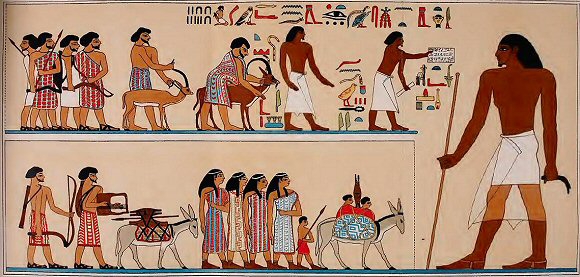correspond to Genesis 42-44 reporting
the circumstances of the arrival
of the eleven brothers of Joseph in Egypt

The fresco in the tomb of the nomarch Khnum-Hotep II
in Beni-Hassan
An "Asiatic" district in the pyramid city of Kahun named by Greeks
the "Egyptian labyrinth"
THE FIRST ARRIVAL OF "ASIATICS"
IN EGYPT
Moreover, under a pavement of the temple of god Montu at Tôd four boxes in bronze were found containing a large amount of precious objects. In one of these boxes bearing the cartouche of Amenemhat II (Sesostris II's predecessor) were 145 cups and bowls of silver. Most of them have been crushed to save space. Only ten bowls have been kept in form, not far from a golden cup.
Indeed, in chapter 44, § 1 of the book of Genesis, Joseph son of Jacob cites specifically the cup he used to drink and to practice divination. And in chapters 42 to 44 it is largely talked about the money brought to Egypt by Joseph's brothers who came to buy corn. But at this time, currency did not exist. So it could deal with ingots of metal (gold, copper or silver) or precious objects.
So, we can imagine that this offering to the temple was made under the reign of pharaoh Sesostris II (son of Amenemhat II), who had allowed the tribe of Bedouins represented on the fresco of Beni Hassan to remain living in Egypt.
In this tomb, a wall fresco with commentary in hieroglyphs tells us that in the 6th year of reign of Sesostris II (about 1876 B.C.), the nomarch Khnum-hotep (II) went in the East desert to bring back some khôl stone (used to treat eye illnesses). When returning Khnum-hotep and his men escorted a small troop of bedwins coming in Egypt with women and children. They brought with them small livestock and some ingots of copper carried by donkeys, who served of currency for commercial exchanges.
The chief of the tribe named himself as the "heka khase Abish" prince of the mountaneous country of Abish*. The hill of Al Habis is today in Jordan above the site of ancient Petra and near the Moses' Valley (diaporama : click on the first picture, then on the "next" button in the upper right corner).
This small troop of thirty-seven "Aamou" (Amorites) evokes the arrival of the tribe of Jacob (70 people) arriving in Egypt on the request of Joseph minister of Pharaoh according to the Bible (Genesis 46).
(Egyptians took only men in account ).
*We can also remark that the grandson of the Babylonian king Hammurabi (the son of his son Samsuiluna) was named Abieshu.